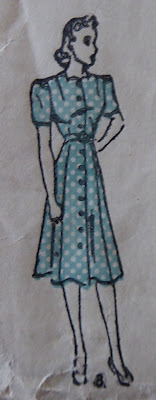 |
| Yes. Again. |
Guess who has been distracted from her MakeNine2022 goals?
This all started a couple of weeks ago, when I went to an event at Maggie Mae's Vintage in Shrewsbury. (An actual event!! With people! Woot!) It was the first time I'd been there, but it won't be the last - the shop has a wonderful selection of true vintage and reproduction pieces, and stocks lots of vintage-style brands such as House of Foxy, Fatale Cosmetics and What Katie Did.
I had a great day and met some lovely people, and bought a hat! (Being short-waisted means that most RTW clothing doesn't fit me, but hats of course are an entirely different matter.) It's a fabulous black felt number trimmed with a veil, and black felt decorations on scarlet barbs which I think are meant to be wheat stalks.
 |
| Hat goodness |
Of course, such a hat needs a suitable dress to go with it. It looks very late 1930s/early 1940s, so I wanted something from that era and fairly plain - mainly so as not to distract from the hat, but also because frills are on the list of Things I Do Not Wear. View A of this pattern fits the bill nicely.
 |
| Butterick 7598, 1937 |
The pattern has variable seam allowances - ¾" for seams which might need letting out, and ⅜" everywhere else. As usual, I traced off a copy to work with, and decided to simplify things with ⅝" allowances all round. Trying to simultaneously do this, shorten the bodice, increase the whole thing by one size and add a full bust adjustment, it's not surprising that it took me a while to notice that the neckline looked nothing like the one on the pattern envelope.
 |
| Spot the difference(s) |
Clearly at some point the previous owner decided to alter the pattern to have a neckline more like the one on my Autumn Roses dress but without a front opening.
 |
| Detail from Advance 2229, 1939 |
Fortunately, the pattern still has its front and back facings, unaltered. By laying these over the main pieces, it was possible to see what the pattern pieces should look like.
 |
| What the bodice front originally looked like |
 |
| The back neckline was cut down to match |
After all this, I decided that the easiest approach was to work step-by-step rather than try to do everything at once. So, I have drawn up the correct bodice front and back pieces without any seam allowances or alterations. The next job is to attach them to Nancy to see where changes need to be made.





























